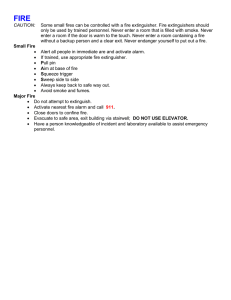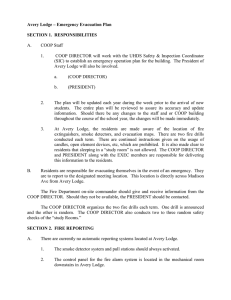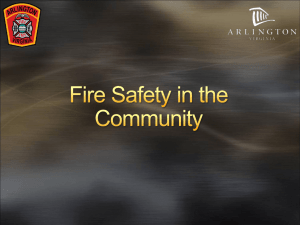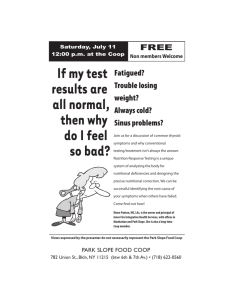Oxford House Evacuation Plan SECTION 1. RESPONSIBILITIES A.
advertisement
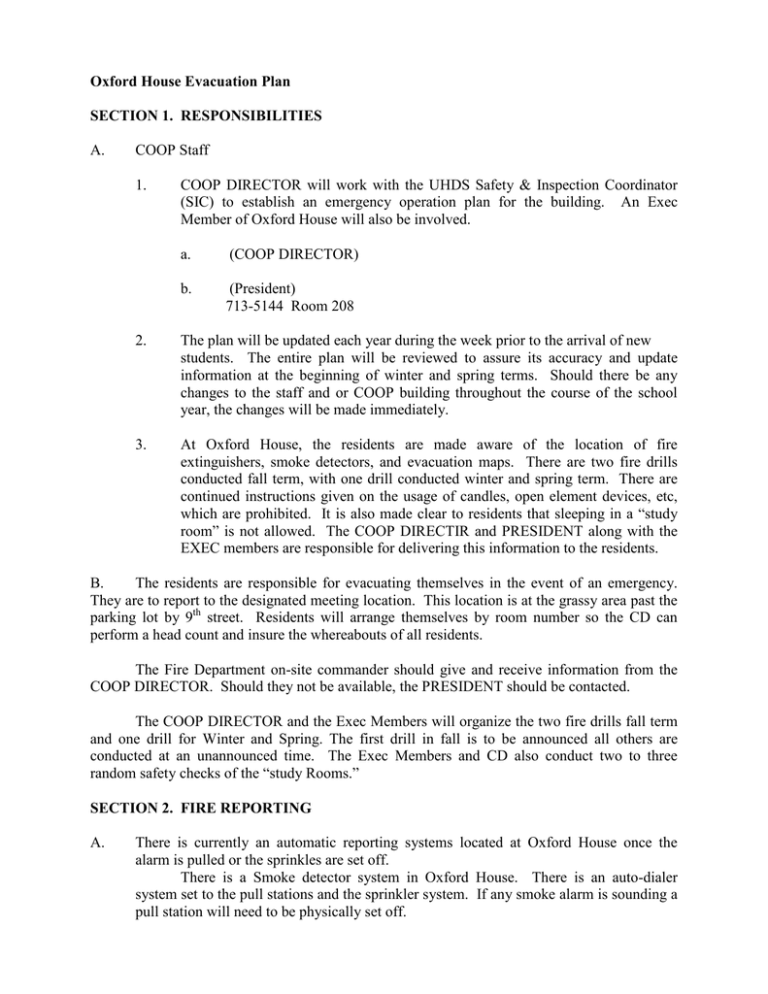
Oxford House Evacuation Plan SECTION 1. RESPONSIBILITIES A. COOP Staff 1. COOP DIRECTOR will work with the UHDS Safety & Inspection Coordinator (SIC) to establish an emergency operation plan for the building. An Exec Member of Oxford House will also be involved. a. (COOP DIRECTOR) b. (President) 713-5144 Room 208 2. The plan will be updated each year during the week prior to the arrival of new students. The entire plan will be reviewed to assure its accuracy and update information at the beginning of winter and spring terms. Should there be any changes to the staff and or COOP building throughout the course of the school year, the changes will be made immediately. 3. At Oxford House, the residents are made aware of the location of fire extinguishers, smoke detectors, and evacuation maps. There are two fire drills conducted fall term, with one drill conducted winter and spring term. There are continued instructions given on the usage of candles, open element devices, etc, which are prohibited. It is also made clear to residents that sleeping in a “study room” is not allowed. The COOP DIRECTIR and PRESIDENT along with the EXEC members are responsible for delivering this information to the residents. B. The residents are responsible for evacuating themselves in the event of an emergency. They are to report to the designated meeting location. This location is at the grassy area past the parking lot by 9th street. Residents will arrange themselves by room number so the CD can perform a head count and insure the whereabouts of all residents. The Fire Department on-site commander should give and receive information from the COOP DIRECTOR. Should they not be available, the PRESIDENT should be contacted. The COOP DIRECTOR and the Exec Members will organize the two fire drills fall term and one drill for Winter and Spring. The first drill in fall is to be announced all others are conducted at an unannounced time. The Exec Members and CD also conduct two to three random safety checks of the “study Rooms.” SECTION 2. FIRE REPORTING A. There is currently an automatic reporting systems located at Oxford House once the alarm is pulled or the sprinkles are set off. There is a Smoke detector system in Oxford House. There is an auto-dialer system set to the pull stations and the sprinkler system. If any smoke alarm is sounding a pull station will need to be physically set off. B. 1. The residents and staff of Oxford House are aware of the location of the smoke detectors and the fire extinguishers. 2. In the case of an emergency, campus security is notified by the COOP DIRECTOR and or an Exec Member. Should neither of them be available, any able person should contact campus security. In the event that campus security is unable to be reached 911 should be called. When a resident/staff member notifies campus security or 911 or 541-737-7000 of an emergency by telephone, the following information should be transmitted: 1. 2. 3. 4. 5. Oxford House, 957 SW Jefferson, Corvallis, OR Floor number Location (room number or area) within the building (if known)* Nature of fire or emergency Name and phone number of person making the call (713-5310 if calling from house phone). 6. What (if anything) is being done to fight the fire Important: Stay on the line until told to hang up! Comments: Building personnel must be able to give campus security/ emergency operator all the information they may need. *Note: Do not take extra time to gather information…Safety first! SECTION 3. EVACUATION A. Due to the nature of the COOP, there are not any specified residents/staff persons assigned to each floor. Each resident is responsible for evacuating her room and closing all doors on their way out. Do not take any extra time evacuating the building and remember safety first! Once at the designated meeting area, they are to report any known missing roommates that are thought to still be in the building. B. Should the COOP DIRECTOR, PRESIDENT, or other EXEC member not be around, another able bodied resident should take charge and ensure that all residents are out of the building and that campus security has been contacted. C. All residents are given copies of this plan and are made aware of the evacuation routes and procedures. They are to follow all orders from the COOP DIRECTOR, PRESIDENT, other EXEC members, or who ever is in charge during an emergency situation. D. Should there be any residents that are unable to evacuate themselves, any able-bodied resident or staff person will provide assistance at the time of the evacuation. Do not attempt to re-enter the building, notify campus security or the emergency operator immediately. If evacuation with assistance is not possible the resident should wait by the open window of the room they are in for the fire department to retrieve them. E. After evacuating, walk directly to the meeting area. SECTION 4. FIRE CONTROL PROCEDURES 1. 2. 3. 4. 5. 6. 7. 8. 9. Pull the pull station and evacuate the house. Call 911 immediately, then call Public Safety (541-737-7000). Notify the COOP DIRECTOR, VICE PRESIDENT, or other EXEC members present. Call the RLT on Duty. Close doors if possible on your way out of the building. Meet arriving firefighters at door(s), outside. Shut down utilities (only if requested by firefighters). Inform residents of informational meeting areas outside of the building. Take further director from Firefighters or RLT. SECTION 5. POST FIRE OPERATIONS After the fire is out and the emergency is over, the COOP DIRECTOR, PRESIDENT, or other EXEC member is responsible for security and working with the Building Inspector and FIRE Prevention Bureau to determine when the building can be safely re-occupied. The RMF Supervisor establishes procedures for returning the building to operational condition and will coordinate actions: 1. 2. 3. 4. When local authorities allow reoccupation of building. Security of any damaged area. Return of the building and fire protection systems to normal operation. Debris removal. SECTION 6. BUILDING EQUIPMENT TESTING A. The following is a list of systems that this building is equipped with. 1. B. Fire alarm systems a. Smoke detector b. Manual pull stations c. Fire extinguishers d. Sprinklers It is the COOP DIRECTOR’S responsibility to become familiar with all of the emergency systems in the building. A copy of all FP&P systems’ manuals should be placed in an emergency box or location, which is accessible to Fire Department personnel. Currently this information is available from campus security or university maintenance staff. C. The university maintenance staff is currently responsible for performing checks of all equipment located in Oxford House. SECTION 7. PROVIDE A LIST OF AREAS THAT CONTAIN ITEMS OF HIGH VALUE susceptible to water damage, susceptible materials, assembly rooms, and rooms containing above-average amounts of combustible materials or hazardous materials 1. The room in the basement with door second from the left as one descends the stairs is used for storage of cleaning supplies. 2. The downstairs lounge has house bought couches and a big screen TV. 3. Study rooms on the 2nd and 3rd floor contain student belongings 4. Coop director apartment contains personal belongings and a UHDS Computer. 5. The Beau parlor contains the common use UHDS Computer. SECTION 8. THE FOLLOWING NAMES AND TELEPHONE NUMBERS SHOULD BE LISTED IN THIS PLAN AS WELL AS POSTED ON THE CONTROL ROOM WALL. A. Building Owner: University Housing and Dining Services B. Facilities Manager: Assoc. Director UHDS C. UHDS Safety & Inspection Coordinator: D. Service Companies 1. Alarm Systems: RMF 2. Communications: RMF 3. Glass Contractor: RMF 4. General Contractor: RMF E. Insurance carrier for the building: UHDS EMERGENCY PROCEDURES FOR COOP Director Always assume an alarm is real. Read and learn the Employee Emergency Procedures Manual, and keep it accessible. Participate in all drills and training. Know at least two safe exit routes prior to an emergency. Take time to familiarize yourself with all fire exits prior to an emergency. IF YOU ARE THE ONE TO DISCOVER FIRE OR SMOKE: 1. 2. 3. 4. 5. Alert and remove people in immediate danger by the manual pull station located by each stairwell if the alarm has not sounded. Begin evacuation procedures. Stay calm; walk. Notify the Fire Department (9-1-1) or 541-737-7000. Once you leave the area Do NOT return. Safety First! Listen for and follow directions of Fire Department personnel or building staff. 6. Once in the stairwells, stay to the right, holding the handrail; and allow others to enter the stairwell. Do NOT block traffic. If you are in an enclosed office or room when an alarm has sounded: FIRST FEEL THE DOOR: A. IF THE DOOR IS WARM: 1. 2. 3. 4. 5. 6. 7. Do NOT open it. Call the Fire Department 541-737-7000 or (9-1-1), notifying them of your exact location. Place a cloth along the bottom of the door to keep smoke out. Close as many doors as possible between you and the fire or smoke. Place a sign on the window for the firefighters to see. Stay calm and wait to be rescued; you will be found. Do NOT break the window. B. IF THE DOOR IS COOL: 1. Open it cautiously, and be prepared to close it if there is excessive smoke. 2. Proceed to the exit. Stay low, or crawl and keep your eyes closed as much as possible if smoke is present. If you or anyone in your building will need assistance evacuating because of sight or hearing impairment, disability, or restricted mobility, notify your COOP DIRECTOR so they can assign two “assistant monitors” to assist with the evacuation. Remember to be prepared, get involved, and – if necessary – be willing to help. IF YOU ARE UNABLE TO USE THE STAIRS BUT CAN MOVE TO THE EXIT: Move to the exit stairwell. If it is free of smoke, wait inside for Fire Department assistance. If the exit is not free of smoke, return to an enclosed area, such as your apartment; and use fire survival skills as described below. If you are waiting in the stairwell, please keep against the wall. Move down a few steps if the landing is crowded so that you don’t block the path of others moving downward. IF YOU ARE UNABLE TO LEAVE YOUR AREA: Physical handicaps or fire conditions in the exit may prevent you from evacuating. In this instance, take action to block off openings, which may allow smoke to enter your unit. Use towels or clothing to block openings around doors or vents where smoke might enter. Put a wet cloth over your mouth and nose. Place a signal in the window. The signal can be anything that will call attention to your location. For instance, tie the curtains in a knot. Place something in the window that would appear unusual, and draw attention to your location. If smoke or fire enters your unit, call 541-737- 7000 or 9-1-1 to report your location. Stay low to the floor to breathe the best air. It is advisable not to open or break windows. Often smoke from the outside of the building can enter through open windows. Breaking windows will put you at great risk to smoke entering from the outside and will hamper rescue efforts below. If you use a wheelchair for mobility, the best practice is to have two persons who can assist you. When an alarm sounds, and after the traffic in the stairway has cleared, the two assistants should wait with you in the stairwell, attempting not to block the exit way. If conditions in the stairwell become threatening, the assistants should carry you to a floor below the fire. If you do not have assistants to help you, your best practice may be to wait in your room or area to close yourself off from smoke. If the conditions in your room or area are threatening, you should attempt to get into the exit stairwell and wait for the Fire Department to assist you. Hall staff must attempt to account for everyone in the pre-arranged meeting areas. If those individuals requiring evacuation assistance were missed or were not found do not return to the building, inform the Fire Department. For questions about fire evacuation or fire prevention, contact your Fire Department. EXPLOSION An explosion can occur from a leaking gas line, gas stove, leaking propane tank, or an explosive device. It may be necessary to partially or fully evacuate the building. Move patients to a safe area and provide care. Call the 9-1-1 immediately and initiate the emergency call list. If the explosion occurs from an explosive device, establish security of the area until law enforcement arrives. Most explosions will cause substantial damage to utilities, which will then need to be turned off at the main controls. All utilities, gas, electricity, water, and fuel should be checked for damage before returning residents to the facility. Telephone Number Location of Master Controls ELECTIRC COMPANY RMF Mechanical GAS COMPANY RMF Kitchen WATER COMPANY RMF Maniacal Room in Basement SPRINKLER SYSTEM RMF Maniacal Room in Basement Room in Basement ALARM SYSTEM RMF 1st floor pull station BASIC GUIDE FOR FIRE SAFETY CHECKS 1. SMOKING • • Smoking policy is posted in the facility. Regulations are enforced (designated outside areas). 2. COMBUSTIBLE STORAGE • • • • • Material is stored “neatly”. Material is NOT stored in boiler room, mechanical rooms, or electrical equipment rooms. Waste and trash are removed regularly. All storage items located at least 18” below all sprinkler heads. All storage rooms are properly lit. 3. OXYGEN • • • • • Cylinders (both full and empty) are chained and not in direct sunlight when stored outside. When in use, cylinders are secure on a stable dolly. Caps are on cylinders when not in use. “No Smoking” signs are on all doors where oxygen is stored or in use. Medical gases shall be stored in areas dedicated to the storage of such gases without other storage or uses. When containers of medical gases in quantities greater than the permit amount are located inside buildings, they shall be in a one-hour exterior room, a one-hour interior room or a gas cabinet in accordance with Uniform Fire Code, Sections 7404.2.1.2, 7404.2.1.3 or 7404.2.1.4. 4. ELECTRICIAL • • • • • • • Extension cords are not used as “permanent” wiring for equipment and ARE NOT USED IN ADA ROOMS No spliced or frayed cords are used within the facility for any reason. “Ganged”, daisy chained, or multiple connections for cords are not in use. Proper sized bulbs are used. Circuits are not overloaded (panel/wiring excessively warm to touch). Emergency power source is operable. Adequate clearance (35” minimum) is maintained for access to electric panels. 5. SPRINKLER AND ALARM • • • • • • • • • Alarm panel indicates “normal” or does not indicate systems is in “trouble”. Fire alarm system is regularly tested and maintained. Manual fire pull stations are available in the path of egress and are not hidden from view. Smoke detectors are regularly tested and maintained. Fire sprinkler inlet and control valves are visible and accessible (36” minimum), not obstructed by storage or other items. No storage located within 18” of sprinkler head on a plane across the entire room. Spare sprinkler heads and sprinkler head wrench are available. Portable fire extinguishers are fully charged and serviced annually. Sprinkler systems regularly tested and maintained. 6. CORRIDORS/COMPARTMENTATION • • • • • • Corridors/exit ways are free of obstructions. Exit doors are plainly marked, are not stuck, locked, or blocked to prevent egress. Smoke/fire doors operate properly and are not propped open. Hazardous area doors are kept closed and not wedged or prohibited from closing. All rooms opening into the corridors latch when closed. Evacuation routes are posted throughout the facility. 7. EQUIPMENT • • • • • • Range hood and filters are free of grease. Range hood suppression system is serviced every six moths. Air conditioning and heating system filters are clean. Dryer lint screens are cleaned frequently, at least once each shift. Areas behind dryers (motors, belts, and pulleys) should be thoroughly cleaned as needed. Dryer lint screens are free of holes. 8. FLAMMABLE LIQUIDS • • • • • Stored in proper containers and limited amounts. “NO SMOKING” signs posted. Proper ventilation is provided. Located proper distance from open flame. Acids and chemicals safely stored.
